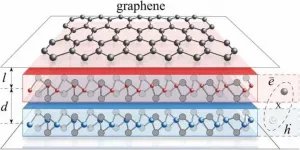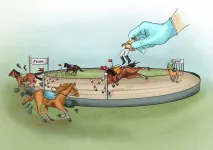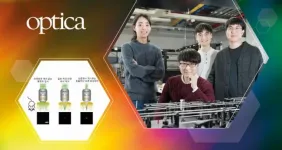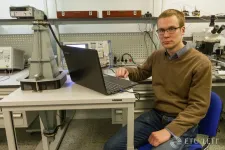(Press-News.org) The concept of interoperability describes the ability of different systems to communicate. This is a major challenge in biomedical research, and in particular, in the field of personalised medicine, which is largely based on the compilation and analysis of numerous datasets. For instance, the COVID-19 pandemic has shown that even when the technical, legal and ethical constraints are lifted, the data remain difficult to analyse because of semantic ambiguities. Under the auspices of the Swiss Personalized Health Network (SPHN) and in close collaboration with representatives from all five Swiss university hospitals and eHealth Suisse, a team of scientists from the University of Geneva (UNIGE) and the University Hospitals of Geneva (HUG), in collaboration with the SIB Swiss Institute of Bioinformatics and the Lausanne University Hospital (CHUV), have developed the strategy for a national infrastructure adopted by all Swiss university hospitals and academic institutions. With its pragmatic approach, this strategy is based on the development of a common semantic framework that does not aim to replace existing standards, but to use them in a synergistic and flexible way according to the needs of the research and the partners involved. The implementation of this strategy, which has already started, marks a crucial step to stimulate research and innovation for a truly personalised medicine in Switzerland. Read more in the journal JMIR Medical Informatics.
Personalised medicine is based on the exploitation and analysis of large quantities of data whether genomic, epidemiological or from medical imaging, to extract meaning. To be able to do this, cross-referencing and aggregating mutually intelligible data is compulsory, even when they come from very different sources.
With this in mind, the Swiss government created in 2017 the Swiss Personalized Health Network (SPHN), an initiative placed under the leadership of the Swiss Academy of Medical Sciences in collaboration with the SIB Swiss Institute of Bioinformatics that aims to promote the use and exchange of health data for research. "Despite major investments over the past decade, there are still major disparities", says Christian Lovis, director of the Department of Radiology and Medical Informatics at the UNIGE Faculty of Medicine and head of the Division of Medical Information Sciences at the HUG. "This is why we wanted, with our partners and the SPHN, to propose a strategy and common standards that are flexible enough to accommodate all kinds of current and future databases."
A three-pillar strategy
We communicate on three main standards: the meaning we give to things, because we must agree on a common basis for understanding each other; a technical standard -- the sound, with which we speak; and finally, the organisation of the meaning and sound with sentences and grammar to structure the communication in an intelligible way. "In terms of data, it's the same thing, explains Christophe Gaudet-Blavignac, a researcher in the team led by Christian Lovis. You have to agree on a semantic, to represent conceptually what has to be communicated. Then we need a compositional language to combine these meanings with all the freedom required to express everything that needs to be expressed. And finally, depending on the projects and research communities involved, this will be 'translated' as needed into data models, which are as numerous as the languages spoken in the world."
"Our aim has therefore been to unify vocabularies so that they can be communicated in any grammar, rather than creating a new vocabulary from scratch that everybody would have to learn anew", says Christian Lovis. "In this sense, the Swiss federalism is a huge advantage: it has forced us to imagine a decentralised strategy, which can be applied everywhere. The constraint has therefore created the opportunity to develop a system that works despite local languages, cultures and regulations." This makes it possible to apply specific data models for only the last step to be adapted to the formats required by a particular project -- the Food and Drug Administration (FDA) format in the case of collaboration with an American team, for example, or any other specific format used by a particular country or research initiative. This constitutes a guarantee of mutual understanding and a huge time saving.
No impact on data protection
However, data interoperability does not mean systematic data sharing. "The banking world, for example, has long since adopted global interoperability standards, stresses Christophe Gaudet-Blavignac. A simple IBAN can be used to transfer money from any account to any other. However, this does not mean that anyone, be they individuals, private organisations or governments, can know what is in these accounts without a strict legal framework." Indeed, a distinction must be made between the instruments that create interoperability and their implementation, on the one hand, and the regulatory framework that governs their accessibility, on the other hand.
Strategy implementation
This strategy has been implemented stepwise in Switzerland since the middle of 2019, in the framework of the Swiss Personalized Health Network. "Swiss university hospitals are already following the proposed strategy to share interoperable data for all multicentric research projects funded by the SPHN initiative", reports Katrin Crameri, director of the Personalized Health Informatics Group at SIB in charge of the SPHN Data Coordination Centre. Further, some hospitals are starting to implement this strategy beyond the SPHN initiative.
INFORMATION:
Superconductivity is a physical phenomenon where the electrical resistance of a material drops to zero under a certain critical temperature. Bardeen-Cooper-Schrieffer (BCS) theory is a well-established explanation that describes superconductivity in most materials. It states that Cooper pairs of electrons are formed in the lattice under sufficiently low temperature and that BCS superconductivity arises from their condensation. While graphene itself is an excellent conductor of electricity, it does not exhibit BCS superconductivity due to the suppression of electron-phonon interactions. This is also the reason that most 'good' conductors such as gold and copper are 'bad' ...
The corona pandemic has ensured that the term "mRNA" is now also known to a large public beyond laboratories and lecture halls. However, the molecule is much more than an important component of a successful vaccine against the SARS-CoV-2 virus. "mRNAs are a central component of all living things on our planet. Without them life as we know it would not function," says Elmar Wolf.
Wolf is a professor for tumour system biology at the Department of Biochemistry and Molecular Biology at the University of Würzburg. With his research team, he has now deciphered new details about the formation of mRNA which provide novel insights into how a fundamental process inside cells works: the transcription. The team ...
A team of researchers, affiliated with UNIST has succeeded in developing a new optical microscope technology, capable of deeper imaging beyond the biological tissues. This breakthrough has been led by Professor Jung-Hoon Park and his research team in the Department of Biomedical Engineering at UNIST.
Optical imaging technology has emerged as an essential research tool for biomedical studies due to its high resolution and good tomography capability. However, the limited penetration depth of the optical microscope makes it difficult to observe biological tissues of more than 100 μm thickness. This is because strong light scattering, caused by various components ...
New York, NY--July 13, 2021--The past decade has witnessed scandal after scandal over private images maliciously or accidentally made public. A new study from computer scientists at Columbia Engineering reveals what may be the first way to encrypt personal images on popular cloud photo services, such as those from Google, Apple, Flickr and others, all without requiring any changes to -- or trust in -- those services.
Smartphones now make it easy for virtually everyone to snap photos, with market research firm InfoTrends estimating that people now take more than a trillion photos each year. The limited ...
A new study reveals the strategies that stop bandits from illegally fishing in Australian waters--but warns there is a cost to the region's poorer countries.
Co-author Dr Brock Bergseth, from the ARC Centre of Excellence for Coral Reef Studies at James Cook University, said poachers are simply following the recurring history of human fishing: intensively fish and devastate local resources, then move further afield to--in these cases--fish illegally or poach in other countries' waters.
"Millions of people rely on fish and seafood and when offered no alternative choice, will chose banditry and illegal fishing ...
A new method of DNA testing on cocoa beans could revolutionise the chocolate industry, offering consumers greater reassurance about the origins and ethics of their beloved confectionery, and giving the global cocoa industry a precision tool to help end slavery and child labour.
Researchers from the University of Bath, University of the West of England, and Surrey Business School have proven a low-cost method which compares DNA in chocolate products to the cocoa when it is farmed. This means cocoa can be reliably traced back from an individual chocolate bar to the specific farms which cultivated the cocoa in it, a major advance on current fairtrading, certification and sustainability practices.
"This has the potential to ...
What the fruit fly is to zoologists, the thale cress is to botanists. The widespread herb with the botanical name Arabidopsis thaliana serves them as a model organism from which knowledge can be gained for other plants. It is therefore extremely well researched - also genetically. For example, it is now known that the genetic material of Arabidopsis thaliana (its genome) comprises around 125 million base pairs. It's like having a Lego manual in front of you that is 125 million letters long and contains everything you need to know to build an Arabidopsis plant.
Similar to humans, different Arabidopsis specimens are generally not genetically identical. If you were to compare the construction manual of all plants of this species, you would encounter differences in about 10 million places, ...
Dr. Iair Arcavi, a Tel Aviv University researcher at the Raymond and Beverly Sackler Faculty of Exact Sciences, participated in a study that discovered a new type of stellar explosion - an electron-capture supernova. While they have been theorized for 40 years, real-world examples have been elusive. Such supernovas arise from the explosions of stars 8-9 times the mass of the sun. The discovery also sheds new light on the thousand-year mystery of the supernova from A.D. 1054 that was seen by ancient astronomers, before eventually becoming the Crab Nebula, that we know today.
A supernova is the explosion of a star following a ...
A new study co-authored by the UBC Sauder School of Business has found that when senior managers mistreat workers, middle managers often attempt to quietly smooth things over.
Robin Hood was known for stealing from the rich and giving to the poor -- but while he may have lived in Sherwood Forest centuries ago, he would have fit right in as a middle manager in today's business world.
Studies have shown that when employees are mistreated by senior leaders, employees can often get back at them by doing things like gossiping, stealing office supplies or calling in sick when they're well. But according to new research from UBC Sauder, middle managers also get in on the act, and attempt to address workplace injustices by secretly helping out their subordinates ...
Kamil Gareev, Associate Professor at ETU "LETI," justified the prospects of using magnetotactic bacteria to treat malignant tumors.
LETI researchers identified the main properties of magnetotactic bacteria and described the possibilities of their application in medicine. The results obtained will help create theranostic agents in neurooncology and cardioprotection. The results of the joint study with colleagues from St. Petersburg State University, RAS Institute of Cytology, and RAS Institute of Biotechnology were published as an overview article in the journal Magnetochemistry.
Magnetotactic bacteria (MTB) are distinguished by their ability to synthesize magnetosomes, special cellular organelles in which magnetite biomineralization occurs. Thanks ...






